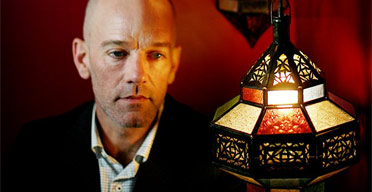When I first fell in love, I was 14. He was 32. I watched him being carried around on a sea of other people’s hands, holding him gently like a god, then tossing him in the air like a plaything. My REM and Michael Stipe fandom was born an ordinary Saturday morning in a living room in south Wales as the video for Drive played on the ITV Chart Show.
Before REM, I was a chart music geek, devouring Now That’s What I Call Music compilations and noting down the Top 5 in my diary. After REM – or more specifically, my love of the multi-platinum-selling Automatic For the People – I burrowed into southern folklore, short stories, experimental film and chiaroscuro art, led by this new guide from Athens, Georgia, with the huge pale blue eyes.
Loving REM felt like rebellion to me. My family were so unrebellious. As mainstays of the Welsh chapel and choir, the music they played at home revolved around classical music or hymns, not keening ballads about boys swimming naked at midnight. REM also made me more confident about being a bit weird. I’d been desperate to please people as a kid, something that came from losing a parent very young just after moving schools and never feeling I really fitted in. Liking anything that wasn’t pearly-bright pop culture, I’d long thought, risked me being marked out.
But this love was too strong. I remember Sellotaping Stipe’s beautiful, unconventional face onto my GCSE revision folder and holding it facing outwards as I walked into school. It sounds ridiculous now, but it felt like a revolution. Here I was, a distinct entity from my family and peer group, allowing myself to follow my own wayward path.
It turned out my friend Claire liked them too, but my love became largely a creative bedroom obsession. I spent my Saturday job money on cassette reissues of their albums, poring through the liner notes as if they were ancient scrolls. I filled notebooks trying to decipher and interpret Stipe’s murky poetry. The moods of Murmur and Reckoning clicked with the cloudy tenor of my adolescence, but I also found out about Man Ray’s photography, Native American history and McCarthyism through REM’s other 80s LPs. I also mined the band’s musical roots, finding Gang of Four and Talking Heads albums in secondhand shops. REM acted as a multi-mirrored kaleidoscopic portal for me, nudging this nervous girl into dazzling new worlds.
I pursued my adventure with commitment and stealth: ordering REM biographies to my tiny local library (to the confusion of the old woman who ran it), and tracking down video compilations like This Film Is On (a compilation of Out of Time videos) and Left of Reckoning (featuring a 20-minute film of REM wandering around a farm, shot using slow-motion and time-lapse techniques). All these things told me that pop music could be clever and weird, but still be accessible and approachable, qualities I desperately wanted to embody.
REM were also successful: I wanted to be this as well, while not compromising who I was. I still love that the video to what is arguably their best-known song, Losing My Religion, references Andrei Tarkovsky’s The Sacrifice and Caravaggio’s paintings of Saint Sebastian and Doubting Thomas, and went on to win six MTV Video awards. I also found REM’s songs and their videos highly charged and erotic; there was so much longing and feeling in them, which helped me articulate mine to myself. I still can’t listen to Star Me Kitten without a 14-year-old’s hormones reigniting inside.
Things changed when Monster came along in 1994, and I saw REM live. Its songs were bold, outward-facing and brash. I wasn’t there yet, plus these songs weren’t half as good. When I saw them in Cardiff Arms Park, I realised they were other people’s obsessions, not just mine. I should have known from that first viewing of Drive that it takes many hands to carry an artist, but I learned to share my fandom as I get older.
As an adult, I’ve made close friends who have shared similarly intense, internal journeys of discovery thanks to REM. As a journalist, I’ve also met the man I fell in love with when I was 14. By the time it happened, I was the 32-year-old in the room, making a living out of the love of music and research that essentially began with him.
It was the last day of interviews that Stipe, then 51, was doing before REM split. He told me things I didn’t discover in the library or work out in my notebooks, which was thrilling, but he also said how precious it had been to have an audience that allowed him to make things. “A moment in music or a lyric or something that’s more tangible … that people have allowed you to do that, it just doesn’t get better.” It made me realise that fans can be gods and playthings to musicians, too. We lift each other up.










